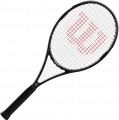Racquet length
Length refers to the distance between the top of the head and the bottom of the racquet handle. This indicator for most rackets for adults is in the
range of 68-69 cm. Longer models in fact can provide a stronger hit, especially when serving, but are more difficult to manoeuvre during play. The International Tennis Association does not allow racquets longer than 74 cm to be used in tournaments.
String surface area
There is a simple pattern here: the larger the area of the string surface and the lower the rigidity of the string tension, the higher the impact force and the lower its accuracy. This parameter is directly related to the string formula.
Now on the market there are rackets with the following string surface area:
Midsize (452 – 574 cm²),
Midplus (580 – 677 cm²),
Oversize (710 – 742 cm²).
String pattern
A string pattern is a scheme for stretching racquet strings. Represents two numbers: the first of them is the number of longitudinal strings, and the second is the number of transverse ones. A racquet with a lower string density will provide more power, while a higher density racquet will provide better ball control. It is important to pay attention to the fact that the same string pattern on rackets with different head areas will provide different stiffness. For example, a racquet with a Midplus head and a 16x19 formula will be stiffer than a similar model with an Oversize head.
Handle size
It is customary to read that the thickness of a tennis racquet should be such that when it is grasped between the fingers and the palm there is a gap slightly larger than the thickness of the index finger. There are two generally accepted systems for measuring handle thickness: American and European. If within the first one, the indicator is measured in inches, then within the European one — in integers from 0 to 5, where zero is the smallest size. Usually, each racquet is presented on the market with modifications with a different handle diameter. So, the indicator "1-5" means that the model is represented by modifications with a handle diameter of 1, 2, 3, 4, 5. Exceptions may be some children's rackets, for which the manufacturer sometimes does not indicate the diameter of the handle, since it is less than size 0.
Case
The racquet is equipped with a special
case for its storage and carrying, which protects the body from scratches, and the strings from reducing the tension.

